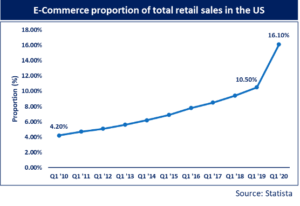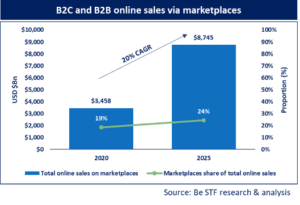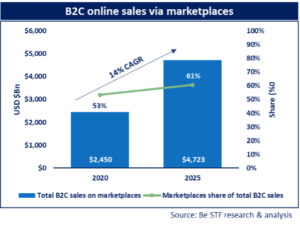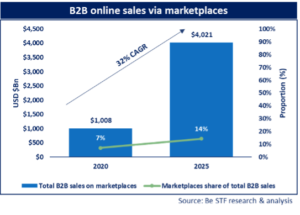Online marketplace payments to hit USD $8.7 trillion by 2025
COVID-19 has changed the way consumers and businesses shop. The shift from physical to online sales has been significantly accelerated, with the e-commerce proportion of total sales increasing by nearly as much in one year as it had in the previous decade (see US data in the below graph as an example). Both B2C (Business-to-Consumer) and B2B (Business-to-Business) online sales recorded double digit growth overall in 2020, with physical sales decreasing in terms of both value and volume of transactions.

The astonishing rise of online sales and payments has not gone unnoticed by the investment community. Payment companies like PPRO and Checkout.com, which facilitate online sales, have received significant amounts of investment over the last few months. Other companies such as Stripe, RAPYD, Airwallex or dLocal, which offer a tailored payment solution targeted at marketplaces, have been securing even larger waves of funding. As an example, Stripe’s valuation has nearly tripled in one year, increasing from USD $36 billion (April 2020) to USD $95billion (April 2021).
Such valuations and level of investment do not come as a surprise. Be | Shaping the Future’s (Be STF) latest research estimates that global marketplace sales reached USD $3.5tr in 2020, with this figure forecast to hit USD $8.8 trillion by 2025, at a 20% CAGR. Online marketplace sales are set to drive online sales growth, with marketplaces’ share of total online sales increasing from 19% (2020) to 24% (2025).

There are substantial differences in the maturity of the marketplace concept, and related services and providers, depending on who and where the end user is. We consider both B2C and B2B marketplaces in our forecast.
When it comes to the B2C segment, online marketplaces are highly developed, with marketplaces making up 53% of total B2C online sales in 2020 – this share equates to an USD $2.5 trillion globally. B2C online sales via marketplaces are forecast to increase by a 14% CAGR to USD $4.7 trillion by 2025, with marketplaces capturing a 61% share of total B2C sales.

Online marketplaces’ maturity in the B2C segment is largely the result of the consistent growth that American (i.e., Amazon, eBay, etc.) and Chinese (i.e., Alibaba Group, JD.com, etc.) marketplaces have experienced over the last two decades. This growth has been driven by the marketplaces’ ability to help largely small and medium merchants sell online and expand internationally more quickly and easily.
Two other trends have emerged in recent years. Established merchants such as Walmart, Carrefour, or Galeries Lafayette have launched their own marketplaces, which allow them to increase product variety for their customers, grow revenues through commission fees and minimise stock management costs. Secondly, there has been a proliferation of new ‘pure player’ marketplaces, which have been launched by tech companies. Examples can be found across a variety of sectors such as food delivery (e.g., Deliveroo), beauty treatment booking (e.g., Treatwell), transport (e.g., Uber), etc. There is a common characteristic across both trends: consumers have access to a wider choice of products and services and enjoy greater convenience. At the same time, merchants can target their products and services to an extremely wide base of consumers.
When considering the B2B segment, online marketplaces are still in their infancy with marketplaces accounting for only 7% of total B2B online sales in 2020. The relatively low stage of maturity, when compared to the B2C marketplace segment, indicates a huge opportunity for growth in B2B marketplace sales. Many verticals such as financial services or manufacturers are expected to embrace the marketplace model. As a result, Be STF forecasts that B2B online sales via marketplaces will increase from USD $1.0 trillion (2020) to USD $4.0 trillion (2025) – a 32% CAGR. This will lead marketplaces to account for 14% of total B2B ecommerce sales by 2025 – an increase of 7%.
Online marketplaces are expected to dramatically disrupt the B2B e-commerce space. Potential use cases that could benefit from the marketplace model include manufacturers and franchises, among others. Siemens and Airbus are examples of manufacturers who have established a marketplace, allowing its buyers to purchase complimentary and ancillary products from other sellers, resulting in increased revenues via commission fees. Accor hotel is a good example of a franchise which has embraced a marketplace model, which enables it to control the money flow and deduct its franchiser fees from each transaction in near real-time instead of waiting months as other franchises do.
Given the figures shown above, there is no doubt that success of payment providers whose solutions target online marketplaces will continue to generate interest in the investment community and help them raise significant funds over the next few years. Existing marketplace payments service providers will have a competitive edge, but they will be challenged as the high growth in this sector will attract both the current and newly set-up payments service providers. This represents a threat for incumbent providers such as banks who offer traditional treasury and acquiring services. In a hypothetical scenario in which a tier-1 merchant, whose acquirer is a bank, decides to move into a marketplace model and the bank is not able to support acquiring services for marketplaces, the merchant will likely find a payments service provider who is able to support its new payments needs, resulting in the bank losing a client. This situation could be even worse for the bank if the merchant also has the treasury services with them.
But what do these providers need to offer to win in the marketplace space? Marketplaces have complex payments needs including the ability to split payments, complex payout calculations and set up, local acquiring and Alternative Payment Methods (APMs) support, as well as access to competitive FX rates. We can safely anticipate a strong increase in competition in this area of payments, as providers will need to keep up with the complexities of ever-changing marketplace requirements to win.
For marketplaces, selecting the right payments partner is a critical step for success. Geographic reach, payments capabilities and pricing are usually the key elements assessed by marketplaces to select their payments partner. Choosing the most suitable mix of these elements is not easy. Each element brings its own caveats, for instance, a payments service provider might be marketing that they have global reach across 167 markets but in reality, they might only have local presence in 10 markets and reach the remaining countries via partnership with domestic or regional acquirers. This has a negative impact on conversion rates, as well as obtaining local interchange pricing or not, and additional FX fees.
The nature of marketplaces enables them to scale quickly and expand internationally. While this presents an opportunity, it also brings significant challenges and barriers. Depending on the marketplace configuration (i.e., Merchant of Record vs Non-Merchant of Record), their payments offering and the agreement with the payments partner, marketplaces must consider elements like local KYC regulations, licensing requirements for payments aggregation, payments data localisation needs, competition, and market sizing – to name just a few. Therefore, prior to international expansion, marketplaces are advised to conduct a qualitative and quantitative assessment of these markets which can help them prioritise entry strategy based on the attractiveness (i.e., market sizing size, development, etc.) and barriers (i.e., regulation, competition, etc.) of each market, and cut unnecessary costs.
Marketplaces bring benefits for both buyers and sellers in B2C and B2B commerce and represent a huge opportunity as they are set to take an increasing share of a growing e-commerce market over the next few years. Nevertheless, entering the marketplace space is not easy. The opportunity size varies significantly across markets and segments, while payments requirements and regulations specific to marketplaces are complex. Businesses need a trusted partner to use that experience to advise in this exciting new market sector.








